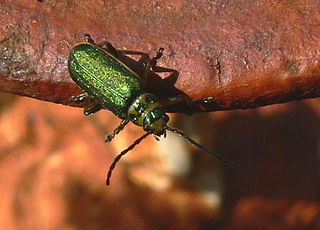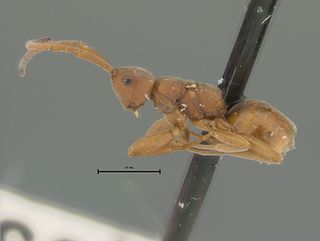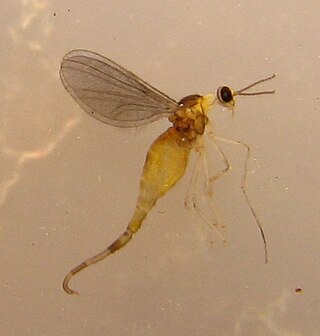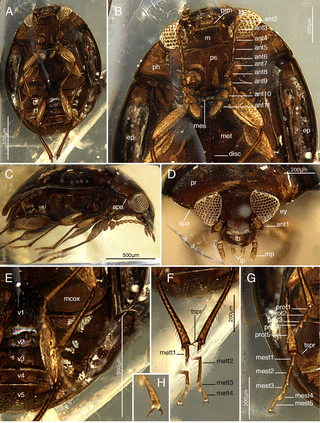
Scydmaeninae are a subfamily of small beetles, commonly called ant-like stone beetles or scydmaenines. These beetles occur worldwide, and the subfamily includes some 4,500 species in about 80 genera. Established as a family, they were reduced in status to a subfamily of Staphylinidae in 2009

The Galerucinae are a large subfamily of the leaf beetles (Chrysomelidae), containing about 15,000 species in more than 1000 genera, of which about 500 genera and about 8000 species make up the flea beetle tribe Alticini.
Manobiomorpha is an extinct genus of flea beetles described from the late Eocene Rovno amber of Ukraine. It was named by Konstantin Nadein and Evgeny Perkovsky in 2010, and the type species is Manobiomorpha eocenica.
Psyllototus is an extinct genus of flea beetles described from the late Eocene Rovno amber of Ukraine, and from the Baltic amber of Russia and Denmark. It was named by Konstantin Nadein and Evgeny Perkovsky in 2010, and the type species is Psyllototus progenitor. In 2016, a newly described extant flea beetle genus from Bolivia, Chanealtica, was found to be most similar to Psyllototus, based on the characters available for observation.
Crepidodera decolorata is an extinct species of flea beetles described from the late Eocene Rovno amber of Ukraine.
Glipostena ponomarenkoi is an extinct species of beetle in the genus Glipostena. The species was described from the late Eocene Rovno amber of Ukraine in 2009.

Raphidiidae is a family of snakeflies in the order Raphidioptera.

Embolemidae is a family of small solitary parasitoid wasps with around 70 species in 2 genera distributed around the world. The few species whose biology is known are parasites on planthopper nymphs of the families Achilidae and Cixiidae. There is debate regarding the status of the genus named Ampulicomorpha by Ashmead in 1893, generally considered now to be a junior synonym of Embolemus (e.g.,), though some authorities dispute this (e.g.,)

Rovno amber, occasionally called Ukrainian amber, is amber found in the Rivne Oblast and surrounding regions of Ukraine and Belarus. The amber is dated between Late Eocene and Early Oligocene, and suggested to be contemporaneous to Baltic amber. Major exploration and mining of the amber did not start until the 1990s.

Nylanderia pygmaea is an extinct species of formicid in the ant subfamily Formicinae known from fossils found in the Prussian Formation of the Baltic region.
Paleomolpus is an extinct genus of leaf beetles in the subfamily Eumolpinae. It contains only one species, Paleomolpus hirtus. It is known from late Eocene amber from Denmark. The generic name is derived from the Ancient Greek palaios and -molpus. The specific name, Latin for hairy, refers to the pubescent dorsum of the species.
Taphioporus is an extinct genus of leaf beetles in the subfamily Eumolpinae. It is known from Baltic and Rovno amber from the upper Eocene.

Winnertziinae is a subfamily of gall midges and wood midges in the family Cecidomyiidae.

Cyclaxyridae are a family of beetles in the superfamily Cucujoidea. The only living genus is Cyclaxyra, with two species endemic to New Zealand. Other species have been named from fossils. They are also known as sooty mould beetles due to the association of Cyclaxyra with sooty mould. The extant species are mycophagous, feeding on spores, conidia, and hyphae.
Proneuronema is an extinct genus of lacewings in the neuropteran family Hemerobiidae known from fossils found in amber. The genus currently contains three species, P. gradatum and P. minor from Baltic amber and P. sidorchukae from Rovno amber. A Ypresian fossil from Washington state was initially also placed within the genus, having been moved from its original placement as Cretomerobius wehri, but was subsequently moved to the separate genus Archibaldia by Vladimir Makarkin (2023).

Embolemus is a genus of wasps belonging to the family Embolemidae. There is debate regarding the status of the genus named Ampulicomorpha by Ashmead in 1893, generally considered now to be a junior synonym of Embolemus (e.g.,), as a few authorities dispute this (e.g.,).
Chaenothecopsis polissica is a species of fossilized pin lichen in the family Mycocaliciaceae that was discovered in 2021 by Vasyl Heluta and Maryna Sukhomlyn. The holotype was recovered from Rovno amber, which formed in the Ukraine during the late Eocene.
Berestella is a genus of wood midges in the family Cecidomyiidae. The only described species - Berestella insuperabilis - is only known from Rovno amber from the Late Eocene. The genus was established in 2007 and named for Ukrainian entomologist Zoya L. Berest.

The Mezhigorje Formation is a geologic formation in Belarus and Ukraine that dates to the Early Oligocene. Rovno amber is found in this formation and it has been studied since the 1990s.
The Obukhov Formation is a geologic formation in Belarus and Ukraine that dates to the Late Eocene; the Obukhov Formation is equivalent to the Prussian Formation of Russia.









